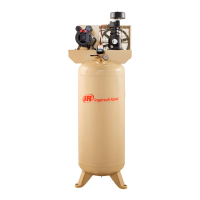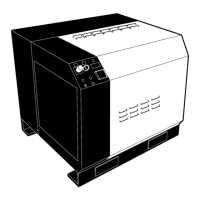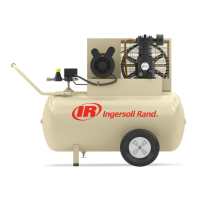How to fix oil leakage from shaft seal in Ingersoll-Rand SS3?
- RRobin HernandezJul 25, 2025
If you experience oil leakage from the shaft seal of your Ingersoll-Rand Air Compressor, replace the seal or the crankshaft assembly.
How to fix oil leakage from shaft seal in Ingersoll-Rand SS3?
If you experience oil leakage from the shaft seal of your Ingersoll-Rand Air Compressor, replace the seal or the crankshaft assembly.
What to do if Ingersoll-Rand Air Compressor has oil in discharge air?
If there is oil in the discharge air (oil pumping) of your Ingersoll-Rand Air Compressor, inspect the bearings and replace the crankshaft assembly if required.
What to do if air delivery drops in Ingersoll-Rand SS3?
If the air delivery of your Ingersoll-Rand Air Compressor drops, inspect the valves and clean or replace them as required.
Why is my Ingersoll-Rand Air Compressor knocking or rattling?
To address knocking or rattling in your Ingersoll-Rand Air Compressor, check the beltwheel, engine pulley, crankshaft, drive belt tension, and alignment. Repair or replace components as needed.
How to fix abnormal piston wear in Ingersoll-Rand SS3 Air Compressor?
For abnormal piston, ring, or cylinder wear on your Ingersoll-Rand Air Compressor, repair or replace the affected components as required.
Overview of key operational and maintenance aspects for the compressor.
Essential safety guidelines to prevent injury and property damage during operation.
Information on potential hazards related to intake air quality for user safety.
Details on risks associated with hazardous voltage and proper electrical safety.
Warnings regarding moving parts and hot surfaces to prevent injury.
Critical safety information concerning high pressure air and risk of bursting.
Further safety measures and operating restrictions for compressor use.
Ensuring piping and fittings meet pressure and temperature requirements for safety.
Step-by-step guide for safely starting and stopping the compressor.
Steps for draining old oil and refilling the compressor pump with new lubricant.
Recommendations for scheduling tank inspections and safety warnings.
A guide to identifying and resolving frequent compressor malfunctions.
Detailed breakdown of possible causes and solutions for operational issues.
Details of the manufacturer's warranty period, coverage, and exclusions.
Legal limitations on the company's liability for damages and claims.
Overview of key operational and maintenance aspects for the compressor.
Essential safety guidelines to prevent injury and property damage during operation.
Information on potential hazards related to intake air quality for user safety.
Details on risks associated with hazardous voltage and proper electrical safety.
Warnings regarding moving parts and hot surfaces to prevent injury.
Critical safety information concerning high pressure air and risk of bursting.
Further safety measures and operating restrictions for compressor use.
Ensuring piping and fittings meet pressure and temperature requirements for safety.
Step-by-step guide for safely starting and stopping the compressor.
Steps for draining old oil and refilling the compressor pump with new lubricant.
Recommendations for scheduling tank inspections and safety warnings.
A guide to identifying and resolving frequent compressor malfunctions.
Detailed breakdown of possible causes and solutions for operational issues.
Details of the manufacturer's warranty period, coverage, and exclusions.
Legal limitations on the company's liability for damages and claims.
This document serves as an owner's manual and parts list for Reciprocating Air Compressors, specifically the Engine Driven Wheelbarrow models SS3 and SS5. It provides comprehensive instructions for installation, operation, and maintenance, along with troubleshooting guidance and a detailed list of parts and accessories.
The Reciprocating Air Compressors, models SS3 and SS5, are designed to generate compressed air for a variety of air tools. These are engine-driven units, indicating they operate independently of an electrical power source, making them suitable for mobile or remote applications. The compressors are capable of continuous duty operation, with the duration depending on the type of lubricant used: 100% continuous duty with Ingersoll Rand synthetic lubricant, and 60% continuous duty (maximum 36 minutes of pumping per hour, not exceeding 10 cycles per hour) with petroleum lubricant. The core function involves a compressor pump that draws in ambient air, compresses it, and stores it in a receiver tank for later use. The engine provides the power to drive the compressor pump.
The manual outlines a clear and safe operational procedure for these air compressors. Installation:
The manual provides a structured maintenance schedule and specific procedures to ensure the longevity and safe operation of the compressor. General Maintenance:
| Horsepower | 3 HP |
|---|---|
| Tank Capacity | 60 gallons |
| Max Pressure | 135 PSI |
| Voltage | 230V |
| Pump Type | Single-stage |
| Power Source | Electric |
| CFM @ 90 PSI | 11.3 CFM |
| Tank Size | 60 gallons |
| Phase | Single-phase |












